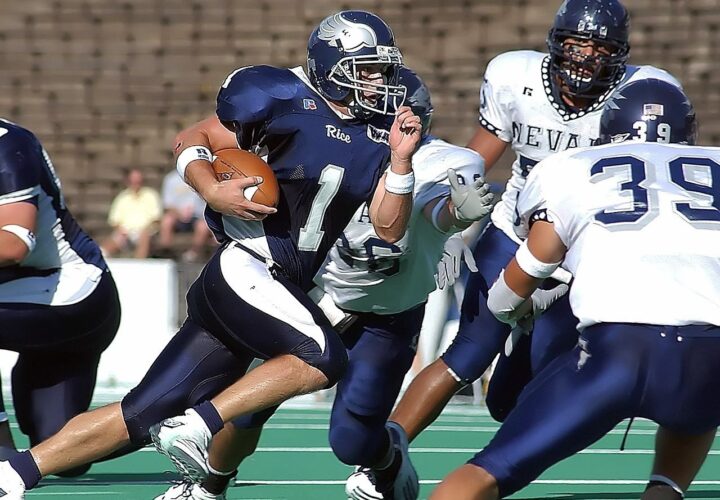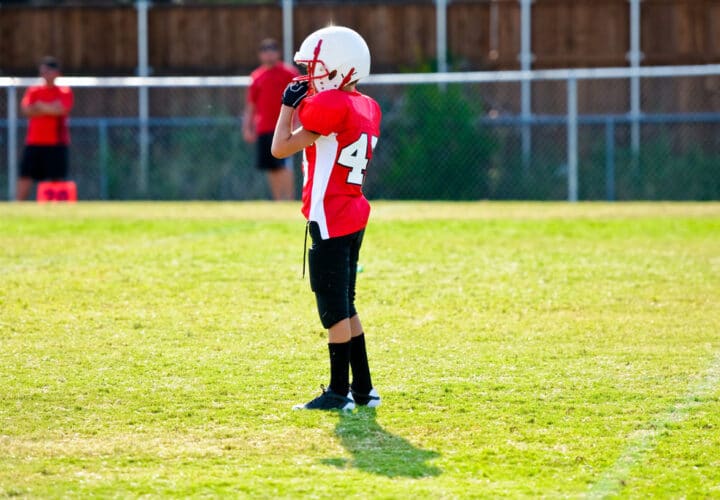A recent study shows that almost three quarters of concussions sustained by college football players occurred during practice, where coaches and trainers have the most ability to prevent injuries. Experts say college football programs need to change their ways to protect the brain health of college athletes.
Concussions are one of the most common injuries in football, and medical experts are increasingly concerned that repeated head traumas could lead to heightened risk of neurological conditions such as CTE (chronic traumatic encephalopathy) — a fatal brain disease. Concussions are sure to occur in football games, but the good news is, experts say head injuries are preventable during practice.
However, new research shows that even preventable concussions are a persistent problem: the vast majority of head traumas in college football — nearly three quarters — occur not at gametime, but in more controllable situations like training sessions. Amid growing recognition of brain injuries in contact sports, the finding fuels the ongoing debate about regulating safety in football training, with experts are asking: Why aren’t college football stakeholders doing more, and following in the footsteps of both the NFL and high school programs to make safety guidelines for practice more stringent?
Among the 68 concussions that happened in the
study period, 72 percent took place
during practice, not at a game.
In the recent study published in JAMA Neurology, researchers analyzed college football players from a national research initiative, which is partly funded by the regulatory organization National Collegiate Athletic Association. The researchers tracked 658 players in six Division I NCAA football programs across five seasons by outfitting accelerometers on their helmets. The data revealed that over two thirds of head impact exposures — blows to the head that can lead to concussions — occurred in practice. Among the 68 concussions that happened in the study period, 72 percent took place during practice, not at a game.
Concussion experts like Chris Nowinski, co-founder and CEO of the Concussion Legacy Foundation, say these findings are no surprise — practice could indeed lead to more head injuries than games, as training sessions occur more frequently and involve a greater number of players. According to Nowinski, the recent study demonstrates that college football has failed to catch up with science, which has long shown that the majority of head injuries in football occur in practice.
“I was disappointed with the findings because it’s not the first time that information is published,” Nowinski told Being Patient. “We’ve known for almost 15 years that most concussions and head impacts in college football are caused in practice. Other levels of football have taken that information and reformed practice. But apparently and frustratingly, college football has not.”
How Can College Football Programs Protect Players From Concussions?
Dr. Michael McCrea, an author of the study and a professor of neurosurgery at the Medical College of Wisconsin, said the findings show that reducing full-contact drills in practice could bring the greatest good — without changing football’s gameplay — in minimizing players’ exposure to head impacts and the risk of brain injury.
“By modifying practices and preseason training, football teams could greatly reduce the risk of injury and exposure for their players,” McCrea said in a news release, “while still maintaining the competitive nature of game play.”
In an editorial accompanying the study, Nowinski and fellow Concussion Legacy Foundation Founder Dr. Robert Cantu, who were not involved in the study, wrote that nearly 40 states have already limited full-contact practices in high school football.
In the NFL, the labor union NFL Players Association reached an agreement with the league in 2011 to place a limit of 14 full-contact practices in a regular season.
Even though the NCAA has advocated for change and issued recommendations, Nowinski and Cantu noted that “guidelines are not rules.”
Meanwhile, NCAA President Mark Emmert said in a news release that the findings of the study will “provide new information for our members to modify rules while continuing education efforts for college athletes across the country.”
However, it’s unclear whether college football will implement any major rules in the near future. The NCAA’s rule-making process can be drawn out, and conferences that play within Division I college football wield major powers to set policies that can differ from one league to another.
Case in point: While head coaches in the Ivy League football conference decided in 2016 to ban full-contact practices during a regular season, Nowinski and Cantu wrote that no other conference has followed suit.
Reforms in training will require buy-in from all key stakeholders, ranging from policymakers and scientists to coaches and athletes, McCrea said — all of whom have the collective responsibility to decrease the risk of brain injuries in college football.
Contact Nicholas Chan at nicholas@beingpatient.com




